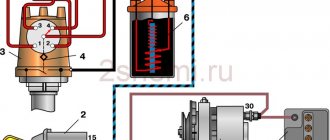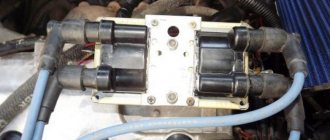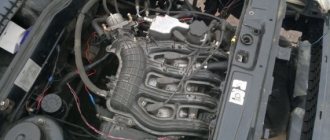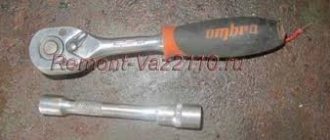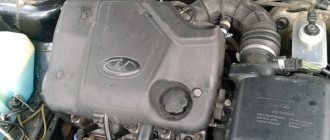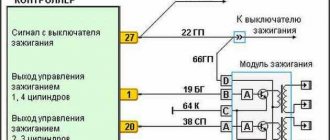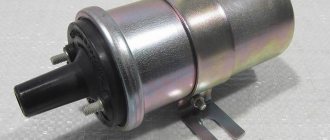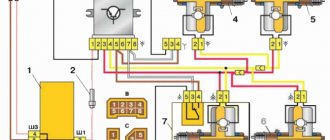ENGINE 11183 1.6L 8-valve JSC AvtoVAZ, the engine is known to car enthusiasts under the names: 11183; engine 21114; 2114; Kalina motor; motor Kalina, etc. VALUE Cylinder displacement, cubic meters. cm - 1.596 Rated power, l. With. (at 5200 rpm) - 82 Maximum torque, Nm (at 2700 rpm) - 120 Number of cylinders - 4 Number of valves per cylinder, pcs. — 2 Total number of valves, pcs. - 8 Cylinder diameter, mm - 82 Piston stroke, mm - 75.6 Spark plugs - A17 DVRM, BPR6ES (NGK), etc. Cylinder operation diagram - 1 - 3- 4- 2 Power system - Injector (distributed injection with electronic control) Fuel Unleaded gasoline AI-92 Fuel consumption, l./100 km. (city/highway) - 8.8/5.7 Lubrication system Combined (splash + under pressure) Type of engine oil - 5W-30, 5W-40, 10w-30 and 10W-40 Amount of engine oil, l - 3.5 Cooling system — Liquid, closed type Coolant — Based on ethylene glycol Motor life, thousand hours. (theory/practice) - 150/300 Weight, kg - 127
Car problems: 1-Reduced speed and traction for a couple of seconds. 2-On gasoline (there is still gas) it makes a little noise... 3-In the dark there is a bright ring of breakdown around the spark plug insulators.
Old high-voltage wires: Tag-No. 9216 01/21/13 13:03:54 PES/SCC SAMARA RUSSIA On the other hand: PES/SCC RUSSIA SAMARA 2190 3707080 rev.00C Wire resistance. 1-5.5 kOhm 2-4.7 kOhm 3- Does not show, infinity. 4- 3.2 kOhm
I bought new high-voltage wires: high-voltage wires with 8 valves. "Milena" 2111-3707080 For all fuel-injected VAZ cars (8kL) Resistance up to 7 kOhm How to connect.
Misfires during engine operation can be caused not only by faulty high-voltage wires, but also by failure of the ignition module. To identify a malfunction of the ignition coil on the Lada Kalina, we will need a multimeter with which we will measure the resistance at its contacts. Measurements are carried out in several stages to determine all possible faults in a particular section of the circuit. I’ll tell you everything in order below:
Check if the winding is shorted to ground
This diagnostic stage is done quite simply and will not take much time. The main thing is to connect everything correctly.
- First, we set the position of the pointer of the device for measuring resistance; I think there is no need to explain this in detail.
- Then you need to connect one contact terminal of the device to the central contact on the coil, and connect the second to ground. If you explained something incomprehensibly, then you can see how it all should look visually in practice. The photo below shows everything perfectly.
Diagnostics of Lada Kalina wires
Before connecting high-voltage wires on Kalina purchased at a car dealership, you need to assess the current state of the car's wiring. For diagnostics, the car owner will need an analog or digital multimeter.
Before connecting the device, you need to inspect the wires for external defects. These include:
If no external damage is observed, you need to connect a multimeter. You need to check the resistance of the armor wire, so you need to switch the device to ohmmeter mode. After this, the armored wire is disconnected from the spark plug and ignition coil. The ends of the wire are connected to the contacts of the multimeter, after which the device will show the current resistance level.
Data on normal resistance values are applied to the insulating layer. For passenger cars, normal values are in the range of 4-10 kOhm. In this case, on one specific car, the data values for individual wires should not differ by more than 2.5-3 kOhm. If this threshold is exceeded, then there is a problem in the ignition system.
There are several ways to check the functionality of the wiring without using measuring instruments:
- Use of additional insulated wire. You need to strip both ends of the additional wire. Short one end to ground, and run the other bare end along the caps, joints and the entire contour of the wire being tested. If there is a defect, the tester wire will give a spark;
- You need to drive the car into an unlit box, open the hood, and start the engine. If there is a breakdown in the VP insulation, the damaged area will spark.
The easiest way is to take a working high-voltage wire and test it on each cylinder by elimination.
Checking the primary circuits of the ignition module for open circuits
In this case, you will need to carry out a different sequence of actions. And below I will try to describe this procedure in more detail:
- It is necessary to connect the device wires to the module contacts, which are located at the edges. That is, to the extreme left and right. You can take a closer look at the photo below.
Ignition module: check and signs of malfunction
The exception is diesel engines. In them, ignition occurs due to high air compression. However, in cars with a gasoline engine, of which the majority are on the road, the ignition coil often fails. Signs of a malfunction may vary.
The video is aimed more at car owners rather than mechanics. A simple life hack is inherently flawed...
A break in the gas distribution pump drive is possible due to a jammed water pump. It is recommended to replace the water pump assembly. To prevent the vehicle from overheating, you should periodically check the operation of the pump. At the first signs of pump failure (extraneous noise, coolant leakage), you should immediately check its functionality.
Engine trouble is a very common problem in fuel-injected cars, one of the reasons for this is...
Worn tie rod ball joint is a common cause of steering failure. At the same time, a crunching sound is heard. The problem is due to a small amount of lubricant. In this case, the CV joint must be replaced.
If the ignition module is faulty, try repairing it yourself. If the MZ turns out to be in good order, the cause of the engine malfunction may be in the high-voltage wires (check) or spark plugs (check). Let us remind you that we previously told you how you can improve the ignition spark.
Checking the secondary windings of the module:
- So, we take the ignition module of the Lada Kalina and turn it so that the conclusions of the high-voltage wires are facing us. Now we connect the device wires to the outputs of the 1st and 4th cylinders. And then we check the 2nd and 3rd cylinders in the same way.
All these testing procedures are best carried out with the module removed; this is much more convenient than doing everything directly under the hood of the car. Removing this part is quite simple, you only need a 5 hexagon and a couple of minutes of time.
The cause of misfires in the operation of the power unit may be not only damage to the high-voltage wires, but also to the ignition module. The article gives recommendations on how to check the ignition coil on a Lada Kalina car with an 8 and 16 valve engine.
How to spot a fake
A few examples of how to visually distinguish original (high-quality) Bosch ignition coils from counterfeits :
- Under the casing of the original, a plastic case is visible (the fake has a metal case).
- There are two stamps on the original casing. They are not present on the fake.
- The outer edge of the original mounting axle box has a protrusion. There is no protrusion on the fake.
- On the fake there is no high voltage symbol (lightning) next to the mounting axle box.
- On the original plug, the font is made more clearly, the surface of the plug is better processed.
- The coding profile of the counterfeit plug is more rounded.
- The fake contacts are noticeably thicker and more rounded.
- The original has traces of casting.
- The factory number on the original is circled in an oval.
- The counterfeit rubber tip does not have a manufacturing date, product type number or logo.
- The extreme turns of the contact spring of the original are wound more tightly.
Other distinctive features with photos are presented in the report, which site users can download:
How to check the serviceability of the ignition coil?
Malfunctions of the ignition module lead to unstable engine operation and the inability to start the car. The module's task is to generate high-voltage pulses and transmit them to the spark plug (SZ). The plus of the unit receives + 12V power from the on-board network, the minus is taken from the car body.
Ignition coil for Lada Kalina
The design of the ignition module for 8 and 16 kL Lada Kalina engines includes two high-voltage transformers (coils) and two control units. One coil is connected to cylinders 1 and 4, and the second to cylinders 2 and 3. The device is connected to the SZ using high-voltage wires.
Individual ignition coils for LADA, which company is better?
On some engines of LADA cars (for example, VAZ-21126, 21127, 21129, etc.), the plant installs individual ignition coils (IKZ).
Currently, there are a large number of counterfeits of these products on the market. Let's find out what to look for when choosing ignition coils. The table of applicability of individual ignition coils is compiled according to catalogs of parts and assembly units:
| Article\Model | Engine | Lada Priora | Lada Kalina 2 | Lada Granta | Lada Vesta | Lada Largus | Lada XRAY |
| 21120-3705010-10 | VAZ | + | |||||
| 21120-3705010-11 | + | + | + | + | + | ||
| 21120-3705010-12 | + | + | + | + | + | ||
| 21120-3705010-13 | + | + | + | + | + | ||
| 21120-3705010-15 | + | + | + | + | |||
| 8200765882 | Renault | + | |||||
| 224332428R | + |
The catalog number of ignition coils installed from the factory indicates its manufacturer:
- 2112-3705010-10 - “BOSCH”, Germany;
- 2112-3705010-11 - "Dynatec" BV, Amsterdam;
- 2112-3705010-12 - JSC "SOATE", Stary Oskol;
- 2112-3705010-13 - “FSUE PO Sever”, Novosibirsk
- 2112-3705010-15 – ELDOR CORPORATION
How to remove the ignition with your own hands?
It is better to check the functionality with the device removed. On an 8-cl engine, the ignition module is located in the front of the car.
Location of module 8 cells
On an engine with 16 cells there are 4 modules and they are located in a different place.
The device removal procedure consists of the following steps:
- First of all, you need to de-energize the car by removing the negative terminal from the battery.
- If the engine has protection, it must be removed.
- Next, press the latch and disconnect the wire block from the unit.
- Then we disconnect the four high-voltage wires and put them aside so that they do not interfere.
- Next, using a key set to “13” you need to unscrew the fastenings of the module to the motor.
- Use a hex screwdriver to unscrew the mounting bolts and remove the device from the engine.
Depending on the tester’s performance, the issue of replacing the device or repairing it is decided. Before installing the module in its original location, its mounts and the engine housing mounts should be cleaned, which will improve the transmitted voltage across the ground. After installation, it is necessary to check the functionality of the engine ignition system.
In order not to make a mistake when connecting high-voltage wires, you need to check the numbers on the block with the numbers on the wires; they must match. You should buy a new module with the same markings that were on the old one. To do this, you need to remember it when removing it. Then there will be no problems when installing a new device.
Location of the marking
Regardless of which engine is installed on the car - 16 cl or 8 cl, checking the coils is the same. If you know how to check the coils of an 8-valve engine, you can check a 16-valve engine. This knowledge will help you save on visiting a car service center.
Operation in various conditions
Many inexperienced drivers, not understanding the essence of the breakdown, decide that an expensive replacement of the ignition switch or the wiring as a whole is necessary. Experienced drivers advise not to rush to conclusions. If, due to various circumstances, the ignition coil fails, the corresponding indicator lights up on the dashboard. The first thing the driver should do in such a situation is to drive the car into the garage and open the hood.
Often spark plugs fail due to a power surge or short circuit. As a result, the spark does not travel properly throughout the system. A number of other circumstances can cause a similar problem:
- the car was damaged in an accident;
- replacement of spark plugs may be required after lightning strikes the car;
- poor-quality previous repairs;
- use of non-original spare parts;
- failure to comply with technical inspection deadlines at the service center.
Regardless of the reason, the ignition circuit needs a full analysis. Often the problem is complex. That is why, if the driver does not have enough technical experience, the first decision that comes to mind should not be accepted as the only correct one.
Signs of a malfunctioning ignition module
Checking the ignition module with a removed spark plug
A malfunction of the ignition module is determined by the following symptoms:
- Difficulty starting a cold engine due to lack of spark on one or more spark plugs.
- Floating engine speed at idle is a situation in which the speed changes without any action on the part of the driver.
- Dips in power, which manifests itself during acceleration and driving up a long climb.
- Decrease in engine power.
- Cylinders 1-4 or 2-3 do not work (engine “troits”).
- Indication of the “Check Engine” indicator.
Possible causes of ignition module malfunction
Despite the high reliability and durability of the ignition module, during operation it can fail, like any other mechanism. Among all possible causes of breakdowns, in 9 out of 10 cases the following occur and are diagnosed:
- Use of inappropriate components in the ignition system. High-voltage wires are selected based on the parameters of the module, since excessively high or low voltage creates malfunctions or burns out contacts.
- Defective or damaged parts, poor quality assembly. Defective components break down faster and damage other components or elements of the system. Practice shows that the selection of high-quality components and their periodic diagnostics allow the module to remain operational for a long time.
Operating principle of the ignition module
It all started when, on the way home from work, for no apparent reason, the engine started to misfire and stopped pulling. Before this, a check light came on on the dashboard, after blinking several times. The problem was solved by stopping and restarting the engine. A few days later the same thing happened again. I decided to diagnose the car.
Operating a car with such a breakdown is possible (you can drive to a garage or car service station), but it is not advisable unless absolutely necessary.
Despite the high reliability and durability of the ignition module, during operation it can fail, like any other mechanism.
Signs of a malfunctioning ignition module
Checking the ignition module with a removed spark plug
A malfunction of the ignition module is determined by the following symptoms:
- Difficulty starting a cold engine due to lack of spark on one or more spark plugs.
- Floating engine speed at idle is a situation in which the speed changes without any action on the part of the driver.
- Dips in power, which manifests itself during acceleration and driving up a long climb.
- Decrease in engine power.
- Cylinders 1-4 or 2-3 do not work (engine “troits”).
- Indication of the “Check Engine” indicator.
Despite the high reliability and durability of the ignition module, during operation it can fail, like any other mechanism. Among all possible causes of breakdowns, in 9 out of 10 cases the following occur and are diagnosed:
- Use of inappropriate components in the ignition system. High-voltage wires are selected based on the parameters of the module, since excessively high or low voltage creates malfunctions or burns out contacts.
- Defective or damaged parts, poor quality assembly. Defective components break down faster and damage other components or elements of the system. Practice shows that the selection of high-quality components and their periodic diagnostics allow the module to remain operational for a long time.
